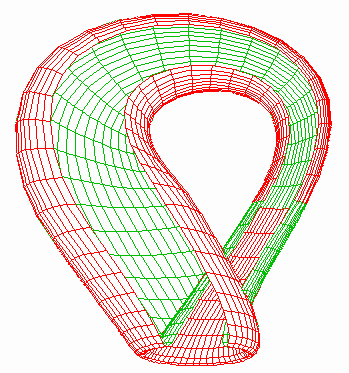Sphere

set nokey set parametric set hidden3d set view 60 set isosamples 30,20 set xrange[-2 : 2] set yrange[-2 : 2] set zrange[-1 : 1] splot [-pi:pi][-pi/2:pi/2] cos(u)*cos(v), sin(u)*cos(v), sin(v) |
Torus

set nokey set parametric set hidden3d set view 30 set isosamples 30,20 splot [-pi:pi][-pi:pi] cos(u)*(cos(v)+3), sin(u)*(cos(v)+3), sin(v) |
Spiral

set nokey set parametric set hidden3d set view 15,50 set isosamples 60,15 set xrange [-8:8] set yrange [-8:8] set zrange [-8:8] set ticslevel 0 splot [-2*pi:2*pi][-pi:pi] cos(u)*(cos(v)+3), sin(u)*(cos(v)+3), sin(v)+u |
A side view...
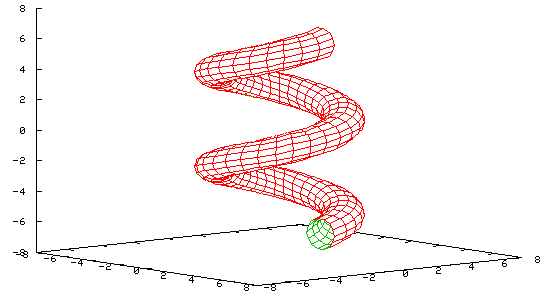
set nokey set parametric set hidden3d set view 80,50 set isosamples 60,15 set xrange [-8:8] set yrange [-8:8] set zrange [-8:8] set ticslevel 0 splot [-2*pi:2*pi][-pi:pi] cos(u)*(cos(v)+3), sin(u)*(cos(v)+3), sin(v)+u |
Conic Spiral - Nautilus

set nokey set parametric set hidden3d set view 65,330 set isosamples 60,20 splot [0:3*pi][-pi:pi] u*cos(u)*(cos(v)+1), u*sin(u)*(cos(v)+1), u*sin(v) |
A top-down view...
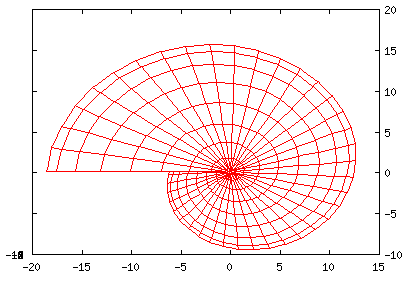
set nokey set parametric set hidden3d set view 0,0 set isosamples 60,20 splot [0:3*pi][-pi:pi] u*cos(u)*(cos(v)+1), u*sin(u)*(cos(v)+1), u*sin(v) |
Conic Spiral - Toroid Consuming Own Tail

set nokey set parametric set hidden3d set view 65,340 set isosamples 60,20 splot [0:3*pi][-pi:pi] cos(u)*(u/(3*pi)*cos(v)+2),\ sin(u)*(u/(3*pi)*cos(v)+2), u*sin(v)/(3*pi) |
A top-down view...
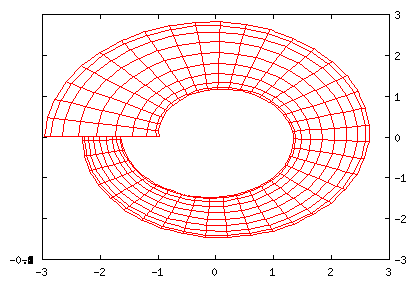
set nokey set parametric set hidden3d set view 0,0 set isosamples 60,20 splot [0:3*pi][-pi:pi] cos(u)*(u/(3*pi)*cos(v)+2),\ sin(u)*(u/(3*pi)*cos(v)+2), u*sin(v)/(3*pi) |
Sea Shell
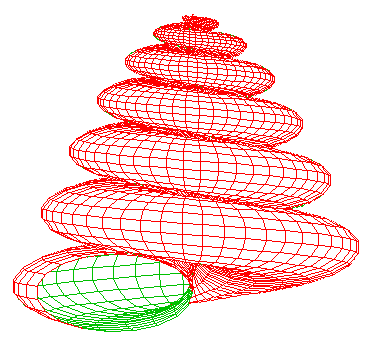
set nokey set noborder set noxtics set noytics set noztics set parametric set hidden3d set view 90,330,1,1.3 set isosamples 300,20 splot [0:13*pi][-pi:pi] u*cos(u)*(cos(v)+1), u*sin(u)*(cos(v)+1), \ u*sin(v) - ((u+3)/8*pi)**2 - 20 |
Trefoil Knot

set nokey set parametric set hidden3d set view 60,0 set isosamples 60,15 splot [-2*pi:2*pi][-pi:pi] cos(u)*cos(v) + 3*cos(u)*(1.5+sin(1.5*u)/2),\ sin(u)*cos(v) + 3*sin(u)*(1.5+sin(1.5*u)/2), sin(v)+2*cos(1.5*u) |
A top-down view...
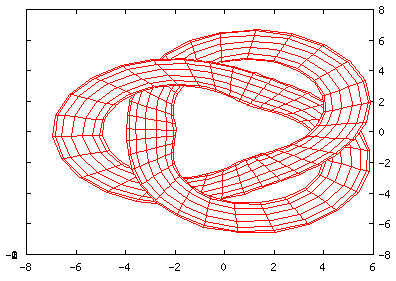
set nokey set parametric set hidden3d set view 0,0 set isosamples 60,15 splot [-2*pi:2*pi][-pi:pi] cos(u)*cos(v) + 3*cos(u)*(1.5+sin(1.5*u)/2),\ sin(u)*cos(v) + 3*sin(u)*(1.5+sin(1.5*u)/2), sin(v)+2*cos(1.5*u) |
Higher-Order Knot

set nokey set parametric set hidden3d set view 30,40 set isosamples 200,15 splot [-3*pi:3*pi][-pi:pi] cos(u)*cos(v)+3*cos(u)*(1.5+sin(u*5/3)/2),\ sin(u)*cos(v)+3*sin(u)*(1.5+sin(u*5/3)/2), sin(v)+2*cos(u*5/3) |
A top-down view...
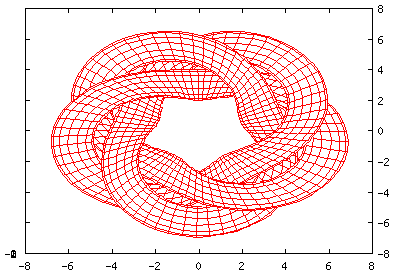
set nokey set parametric set hidden3d set view 0,0 set isosamples 200,15 splot [-3*pi:3*pi][-pi:pi] cos(u)*cos(v)+3*cos(u)*(1.5+sin(u*5/3)/2),\ sin(u)*cos(v)+3*sin(u)*(1.5+sin(u*5/3)/2), sin(v)+2*cos(u*5/3) |
Dini's Surface
Dini's surface has a constant negative curvature (a sphere has a constant positive curvature). It is constructed by twisting a pseudosphere.Mostly, this surface is here because it looks pretty.
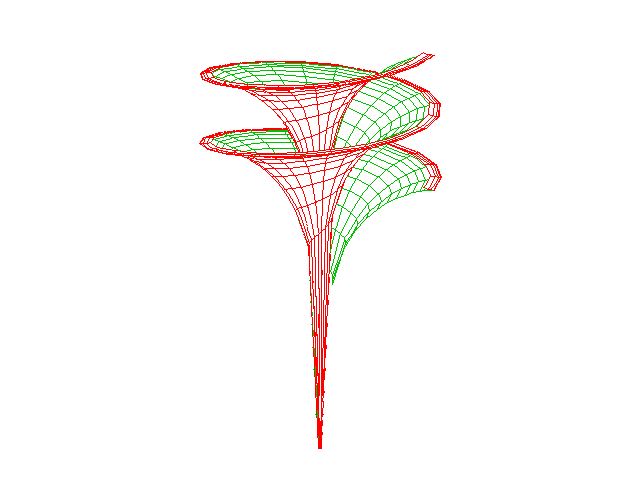
set nokey set parametric set hidden3d set noautoscale set view 70, 20, 7 set isosamples 40,20 splot [0:4*pi][0.001:2] cos(u)*sin(v), sin(u)*sin(v), \ cos(v)+log(tan(v/2))+0.2*u -4 |
Mobius Surface
The Mobius surface (or Mobius "Strip") is a one-sided object, with only one edge. It may appear at first glance to have two sides, however it is possible for one to walk from one side to the other without having to cross the edge - because of the twist.
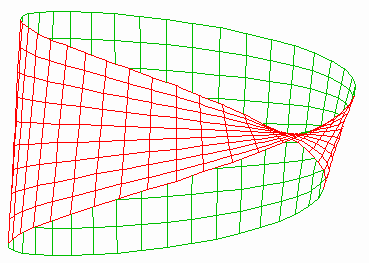
set nokey set noborder set noxtics set noytics set noztics set parametric set hidden set isosamples 40,10 set view 90, 45 splot [0:2*pi][-.1:.1] cos(u) + v*cos(u/2) * cos(u), \ sin(u)+v*cos(u/2)*sin(u), v*sin(u/2) |
Another view...
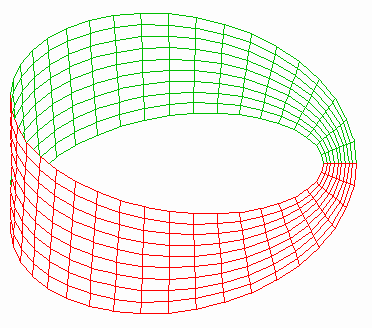
set nokey set noborder set noxtics set noytics set noztics set parametric set hidden set isosamples 40,10 set view 30, 0 splot [0:2*pi][-.1:.1] cos(u) + v*cos(u/2) * cos(u), \ sin(u)+v*cos(u/2)*sin(u), v*sin(u/2) |
Klein Bottle
The Klein bottle, similar to the Mobius surface above, is one-sided; however unlike the Mobius surface, it has no edges. One way to think of it, is as two Mobius strips joined at their edges (the corollary is that if you cut a Klein Bottle in half along its length you get two Mobius strips).A Klein bottle can only really exist in four (or higher) dimentions; in three dimensions the neck of the bottle bends around and must pierce the side of the bottle. In four dimentions the klein bottle does not intersect itself. So what you see below is really a three-dimensional immersion of a four-dimentional object (although it's really a two-dimensional projection of a three dimensional immersion...).
Think of a regular wine bottle with a cork - if you are outside, you cannot get inside without getting past the cork. A bottle is topologically isomorphic to a disc - there's a top and a bottom, separated by an edge. The cork serves the function of blocking the edge of the bottle.
If one were to stick a cork in the neck of a Klein bottle (in the bottom of the figure below), it is still possible to get inside without having to get past the cork. One simply follows the side of the bottle up, around, down to the neck, and through the side, to end-up inside the bottle without ever having to squeeze past the cork. You would have to (along with the neck) squeeze through the side of the bottle without breaking it, but in four dimensions this is easy to do.
A fun site with lots of information, and with real three-dimensional immersions of Klein bottles for sale is available here. A more mathematically rigorous site appears here. (Note that I am not associated with either of these two sites.)
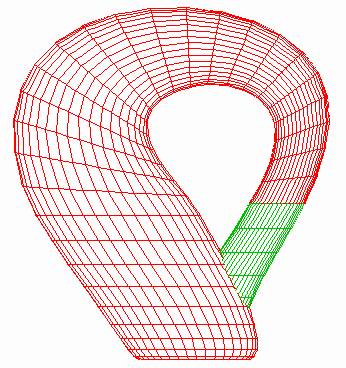
set nokey set noborder set noxtics set noytics set noztics set parametric set hidden set isosamples 40,40 set view 0, 0, 2 set xrange [-25:25] set yrange [-25:25] set zrange [-25:25] #set urange [0 : pi] set urange [0 : 2*pi] set vrange [0 : 2*pi] # switch function: # 0 for x < a # 1 for x > a ##switch(x, a) = (erf(x-a)+1)/2 switch(x, a) = (x > a ? 1 : 0) sw(x) = switch(x - pi) # cross-over function: # a for x < c # b for x > c cross(a, b, c, x) = a * (1 - switch(x, c)) + b * switch(x, c) cr(x) = cross(cos(x), 1, pi, x) splot \ 6*cos(u)*(1+sin(u)) + 4*(1-cos(u)/2)*cr(u)*cos(v+pi*sw(u)), \ 16*sin(u) + 4*(1-cos(u)/2)*sin(u)*cos(v)*(1-sw(u)), \ 4*(1-cos(u)/2) * sin(v) \ |
"Figure-8" parameterisation...
This Klein surface can be constructed by rotating a figure eight about its axis while inserting a twist in it. This results in the figure appearing below. While (in four dimensions) this is topologically isomorphic to the Klein bottle above it's not as aesthetically appealing as the previous figure.
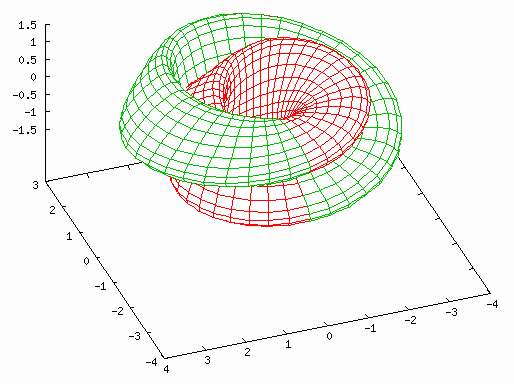
set nokey set parametric set hidden set isosamples 40,40 set view 40, 250 a = 2.0 set urange [-pi/1 : 1*pi/1] set vrange [ 0 : 2*pi] splot \ (a+cos(u/2)*sin(v)-sin(u/2)*sin(2*v))*cos(u), \ (a+cos(u/2)*sin(v)-sin(u/2)*sin(2*v))*sin(u), \ sin(u/2)*sin(v) + cos(u/2)*sin(2*v) |
Three other views...
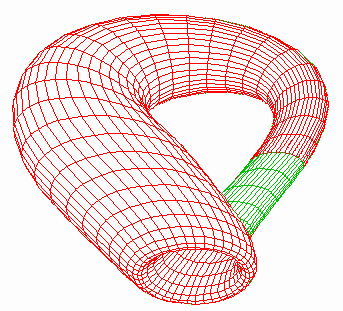
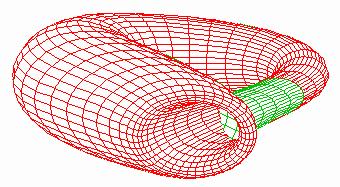
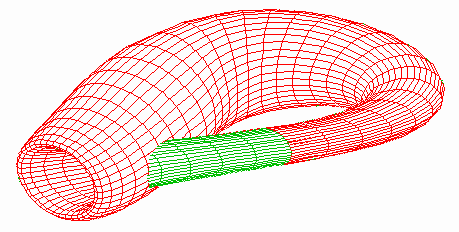
A "Cut-Away" view
Part of the side of the klein bottle has been removed so the "inside" is visible.
